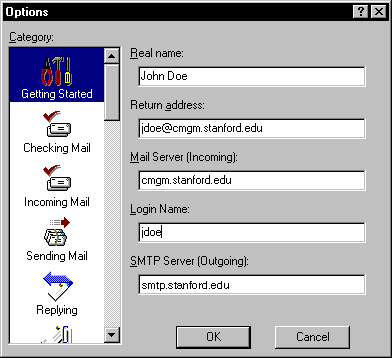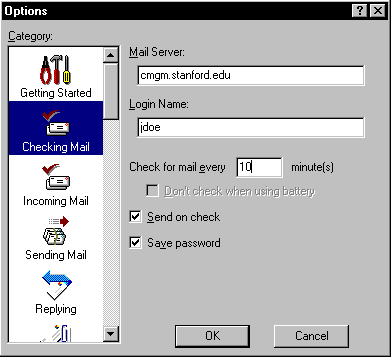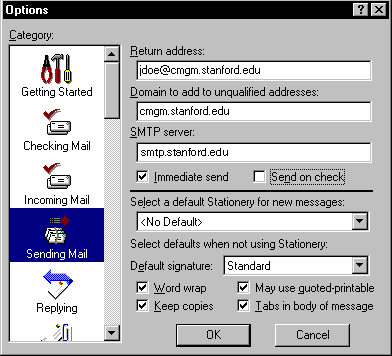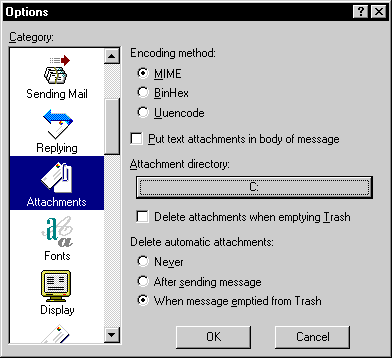| Home | Networking | Remote Access | Software | Security | Services | Support | ||||||||||||||||||||||
|
|||||||||||||||||||||||||||||||||||||||||||||||||||||||||||||||||||||||||||||||||||||||||||||||||||||||||||||||||||||
|
|
||||
| Configuring Eudora for CMGM The following instructions are for configuring Eudora 4.x for Windows to read email from a CMGM account. You should already have a properly working network connection (ie Netscape and PCSamson should be working properly). Select this link to install and configure a network connection on your PC. You should already have installed the Eudora application from PCStanford. |
||||
|
|
||||
| Configure Eudora | ||||
Open the "Eudora Pro" application. You can select "Find" from the "Start" menu and search for the application if you can't easily find it on your desktop or in "Start" menu under "Programs". Open Eudora by double-clicking on the "Eudora Pro" icon. Select "Options" from the "Tools" menu. Scroll to the top of the windowpane on the left side of the window and select the "Getting Started" icon: |
||||
 Figure A |
||||
| For "Real name:" enter your name as you would like it to appear in the email messages you send to others.
You can specify what address the recipients of your emails will reply to. If you want your recipients to reply to your emails to "jdoe@hotmail.com", enter this for the "Return address" field. For "Mail Server (Incoming):" enter "cmgm.stanford.edu" (no quotes). For "Login Name:" enter your CMGM username. If your email account is jdoe@cmgm.stanford.edu your username is jdoe. For "SMTP Server (Outgoing):" enter "smtp.stanford.edu". Select the "Checking Mail" icon from the left windowpane: |
||||
 |
||||
| For the "Mail Server:" field enter "cmgm.stanford.edu", as in the picture above.
For "Login Name" enter your CMGM username. These should be the same values as in Figure A. Enter the number of minutes that should pass between automatic mail checking in the field titled "Check for mail every xx minutes". Setting this value to less than 5 is a bad idea: it increases network traffic and consequently slows email transfers. You can enable the "Save password" feature if you do not want to enter your password every time you start Eudora. This is not recommended for shared computers. Select the "Incoming Mail" icon. |
||||
 |
||||
| Verify that the "POP" radio button is selected for the "Server Configuration" option.
The "Leave mail on Server" option is useful if you are reading your email from more than one computer. Eudora is a POP client, meaning that once it retrieves an email message from CMGM it deletes the message from the CMGM computer and stores it locally. Consequently, if you move to another computer and try to locate an old email Eudora will fail to find it since the email is already stored away from CMGM. You can force Eudora to leave email on the CMGM server for up to 30 days (set the "Delete from server after xx day(s)" option to "30"). Your email will still be stored on your local computer. You can enable the "Skip messages over xx K" feature if you do not wish to download messages over a certain size. This is only useful for computers connecting to the network via slower modem connections. Campus computers with ethernet should definitely leave this option disabled. You should select the "Passwords" radio button (as in the screenshot above) for the "Authentication:" type unless you are using Kerberos. Select the "Sending Mail" icon from the left side fof the "Options" window: |
||||
 Figure B |
||||
| You can specify an alternate return address in the "Return address" field. This should match the return address specified in the "Getting Started" settings in Figure A above.
Enter "smtp.stanford.edu" for the "SMTP Server:" field. Enable the other options in the "Sending Mail" settings window as shown in the screenshot above. Scroll downwards to select the "Attachments" icon: |
||||
 |
||||
| Select the options in the "Attachments" settings window as shown above.
Press the button directly below the words "Attachment directory:" to specify where you want to keep files (Word, Excel) your peers send to you. Click on the "OK" button and select "Check Mail" from the "File" menu to check for any new mail. |
||||
|
Last Updated: Wednesday, April 2, 1999 |
||||